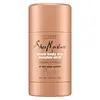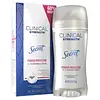Shea Moisture Whole Body Invisible Deodorant Stick Versus Secret Clinical Strength Invisible Solid Antiperspirant Deodorant
What's inside
What's inside
 Key Ingredients
Key Ingredients

 Benefits
Benefits

 Concerns
Concerns

 Ingredients Side-by-side
Ingredients Side-by-side

Cocos Nucifera Oil
MaskingCaprylic/Capric Triglyceride
MaskingMaranta Arundinacea Root Powder
Skin ConditioningHelianthus Annuus Seed Wax
Skin ConditioningOryza Sativa Bran Wax
Skin ConditioningJojoba Esters
EmollientTriethyl Citrate
MaskingButyrospermum Parkii Butter
Skin ConditioningSilica
AbrasiveNiacinamide
SmoothingTocopheryl Acetate
AntioxidantParfum
MaskingAllantoin
Skin ConditioningBisabolol
MaskingZingiber Officinale Root Extract
MaskingBenzyl Alcohol
PerfumingBenzyl Benzoate
AntimicrobialCitral
PerfumingCoumarin
PerfumingLimonene
PerfumingCocos Nucifera Oil, Caprylic/Capric Triglyceride, Maranta Arundinacea Root Powder, Helianthus Annuus Seed Wax, Oryza Sativa Bran Wax, Jojoba Esters, Triethyl Citrate, Butyrospermum Parkii Butter, Silica, Niacinamide, Tocopheryl Acetate, Parfum, Allantoin, Bisabolol, Zingiber Officinale Root Extract, Benzyl Alcohol, Benzyl Benzoate, Citral, Coumarin, Limonene
Ingredients Explained
These ingredients are found in both products.
Ingredients higher up in an ingredient list are typically present in a larger amount.
Parfum is a catch-all term for an ingredient or more that is used to give a scent to products.
Also called "fragrance", this ingredient can be a blend of hundreds of chemicals or plant oils. This means every product with "fragrance" or "parfum" in the ingredients list is a different mixture.
For instance, Habanolide is a proprietary trade name for a specific aroma chemical. When used as a fragrance ingredient in cosmetics, most aroma chemicals fall under the broad labeling category of “FRAGRANCE” or “PARFUM” according to EU and US regulations.
The term 'parfum' or 'fragrance' is not regulated in many countries. In many cases, it is up to the brand to define this term.
For instance, many brands choose to label themselves as "fragrance-free" because they are not using synthetic fragrances. However, their products may still contain ingredients such as essential oils that are considered a fragrance by INCI standards.
One example is Calendula flower extract. Calendula is an essential oil that still imparts a scent or 'fragrance'.
Depending on the blend, the ingredients in the mixture can cause allergies and sensitivities on the skin. Some ingredients that are known EU allergens include linalool and citronellol.
Parfum can also be used to mask or cover an unpleasant scent.
The bottom line is: not all fragrances/parfum/ingredients are created equally. If you are worried about fragrances, we recommend taking a closer look at an ingredient. And of course, we always recommend speaking with a professional.
Learn more about Parfum